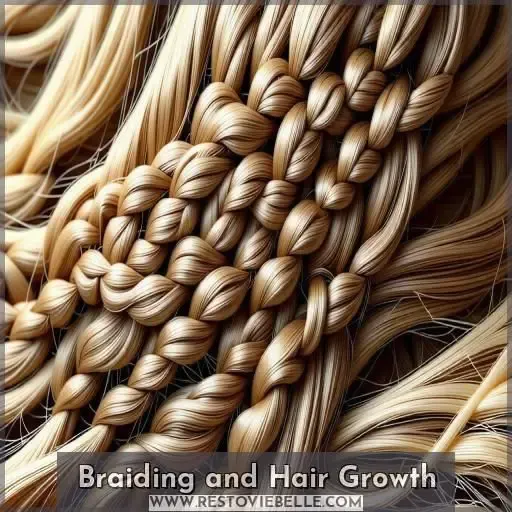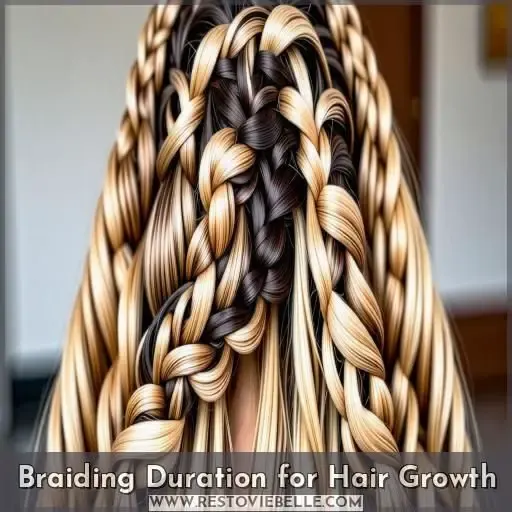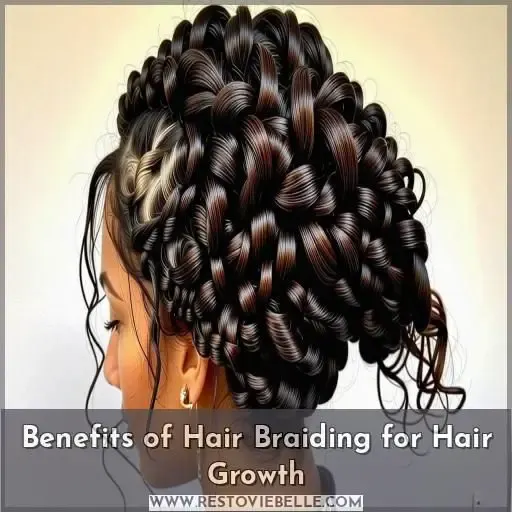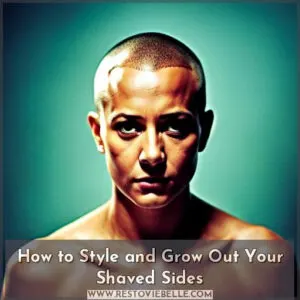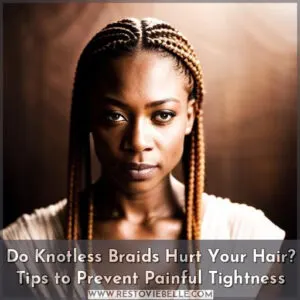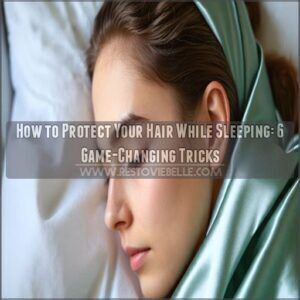This site is supported by our readers. We may earn a commission, at no cost to you, if you purchase through links.
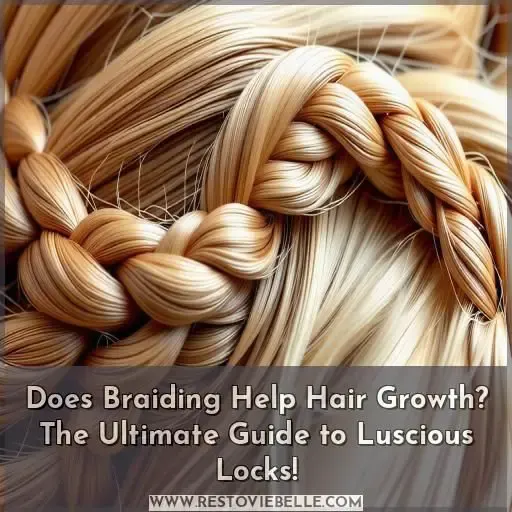 You’re wondering if braiding helps hair growth?
You’re wondering if braiding helps hair growth?
Braiding itself doesn’t directly stimulate hair follicles, but it absolutely promotes growth by reducing breakage and split ends.
It also improves blood circulation, potentially delivering valuable nutrients to those follicles. With the right braiding duration (6-8 weeks is ideal) and maintenance, you’ll create a healthier scalp environment for luscious locks to thrive.
So while braids won’t magically sprout new strands, they protect your hair’s length and prevent damage – key ingredients for growth.
Want to learn more about maximizing this protective style’s benefits?
Table Of Contents
- Key Takeaways
- Does Braiding Help Hair Growth?
- Braiding and Hair Growth
- Braiding Duration for Hair Growth
- Benefits of Hair Braiding for Hair Growth
- Potential Damage From Braids
- Popular Braided Styles
- Braided Hair Care
- Benefits of Hair Braiding: General
- Hair Braiding Services at Harlem Natural Hair Salon
- Frequently Asked Questions (FAQs)
- What are the benefits of braiding your hair?
- Which braids are best for hair growth?
- What speeds up hair growth?
- Can my hair grow without plaiting it?
- Can braids directly stimulate hair follicles?
- How long should braids be left in for hair growth?
- What are the potential damages from prolonged braiding?
- What are the most popular braided styles?
- How should braided hair be cared for to promote growth?
- Conclusion
Key Takeaways
- Braiding itself does not directly stimulate hair follicles, but it promotes growth by reducing breakage and split ends, improving blood circulation to deliver nutrients to follicles, and creating a healthier scalp environment for hair to thrive.
- The ideal braiding duration for hair growth is 6-8 weeks, after which braids should be removed to assess hair condition. Regular scalp and hair moisturizing prevents dryness and breakage, while avoiding tight braiding prevents stress on hair follicles.
- While braiding protects hair from damage and allows it to grow longer over time by reducing split ends, locking in moisture, and shielding strands from harsh elements, prolonged or overly tight braids can damage hair and lead to conditions like traction alopecia.
- Before braiding, hair should be properly washed, moisturized, and detangled to prevent excessive tension and breakage. While braided, the scalp should be regularly cleansed and moisturized to maintain a healthy environment for growth, and braids should be protected with a headscarf or wrap at night.
Does Braiding Help Hair Growth?
Yes, braiding can help hair growth in several ways. Braids reduce breakage and split ends, protect hair from environmental factors, and promote blood circulation to the scalp which may deliver more nutrients to hair follicles.
Braiding and Hair Growth
You’re right to wonder if braiding directly stimulates hair growth – it doesn’t influence the hair follicles themselves. However, braids can play a significant role in retaining length, promoting blood flow to nourish follicles, reducing breakage from environmental stressors, and maintaining a healthy scalp environment conducive to new growth.
Braids Do Not Directly Stimulate Hair Follicles
Braids don’t directly stimulate hair follicles, but they can promote scalp health and hair strength, reducing breakage from tight spirals, heavy extensions, harsh chemicals, and traction alopecia .
Retain Hair Length: Reduced Breakage and Split Ends
Braiding retains hair length by reducing breakage and split ends through proper braid tension management, protective styling, and regular maintenance. This helps protect the hair from damage and supports hair growth.
- Proper braid tension
- Regular maintenance
- Protective styling
- Reduced breakage
Promote Blood Circulation: Potential Nutrient Delivery to Hair Follicles
Braiding techniques that gently massage the scalp may promote blood circulation, potentially delivering essential nutrients to hair follicles for maximal health and growth .
Healthier Scalp Environment: for Hair Growth
Braiding promotes a healthier scalp environment by increasing blood circulation, delivering essential nutrients to hair follicles, and shielding hair from damaging environmental factors that hinder growth.
Protection From Harsh Environmental Factors
Braids shield your hair from harsh sunlight, damaging winds, and extreme temperatures, locking in moisture for healthier, protected locks. Follow hair braiding tips for scalp and hair care.
Braiding Duration for Hair Growth
In the context of braiding for hair growth, the ideal period is 6-8 weeks, after which you should remove the braids to assess your hair condition. Regular scalp and hair moisturizing prevents dryness and breakage, while avoiding tight braiding prevents stress on your hair follicles; proper maintenance is crucial to prevent damage.
Ideal Period: 6-8 Weeks
Ideally, keep braids in for 6-8 weeks to:
- Minimize tension on hair follicles
- Allow for gradual hair growth
- Prevent excessive dryness and breakage
Monitor Hair Condition: Remove Braids if Damage Appears
To monitor your braid duration, watch out for signs of scalp inflammation, hair breakage, chemical damage, and the stress from heavy extensions. Remove braids if damage appears to prevent further hair damage.
Regular Scalp/hair Moisturizing: Prevents Dryness and Breakage
Moisturize your scalp and hair roots regularly with lightweight, oil-based products to prevent dryness, breakage, and promote healthy hair growth under braids .
- Massage oils into scalp for improved circulation
- Spritz braids with water to lock in moisture
- Avoid heavy oils that cause product buildup
Avoid Tight Braiding: Prevents Stress on Hair Follicles
To prevent follicle stress and hair breakage, avoid tight braiding, which can lead to braid tension and scalp inflammation. This helps maintain hair elasticity and reduces the risk of hair loss.
Proper Maintenance: Essential to Prevent Damage
Maintain braids with care to prevent damage. Avoid excessive tension, scalp irritation, and product buildup. Regularly moisturize hair roots to retain moisture and prevent matting. Enjoy long-lasting, healthy hair growth with proper braiding maintenance.
Benefits of Hair Braiding for Hair Growth
While braiding doesn’t directly stimulate hair growth from the follicles, protecting your hair from damage via braiding allows it to grow longer over time. By reducing split ends, locking in moisture, and shielding strands from harsh elements, braided hairstyles like box braids or cornrows help you retain length and maintain overall hair health.
Reduces Split Ends
Braiding reduces split ends by protecting delicate strands and minimizing friction. Proper techniques, extensions, and scalp massage promote healthy hair growth for natural, low-maintenance styles.
Long Lasting
Braids can last for weeks, protecting your hair from damage and allowing it to grow longer by preventing breakage. Explore different braided styles to find your perfect look .
Protects From Damage
Braiding protects your hair from damage by reducing friction, minimizing breakage, and locking in moisture. Styles like box braids and cornrows shield strands from harsh elements, promoting healthy growth.
- Braiding techniques prevent split ends
- Protective hairstyles shield hair from damage
- Extensions add length while braids protect
- Moisture retention keeps hair hydrated and strong
Allows Hair to Grow
Braiding allows hair to grow by reducing split ends, protecting from damage, and maintaining healthy hair. It aids in moisture retention, scalp health, and breakage prevention, supporting overall hair growth secrets and science.
Maintains Healthy Hair
Braids maintain healthy hair by locking in moisture, promoting a nourishing scalp environment, and fortifying strands for enhanced durability and growth. Embrace the benefits of braiding for luscious locks! (Source)
Potential Damage From Braids
While braiding can protect your hair and allow it to grow without excessive breakage, prolonged or overly tight braids can damage your strands and even lead to hair loss conditions like traction alopecia. If you have thin or fragile hair, tight braiding styles may not be suitable, as the constant tension can cause breakage and impede healthy growth.
Prolonged or Overly Tight Braids Can Damage Hair
Prolonged or overly tight braids can lead to hair damage if not managed carefully. To prevent damage, consider these alternatives:
- Opt for looser braiding styles to reduce scalp sensitivity.
- Grant adequate moisture retention by incorporating nourishing oils and lightweight moisturizers.
- Monitor hair health closely, and consult with a professional if you notice any signs of damage.
Sustained Pressure Can Cause Hair Loss Conditions
Tight braids exert constant tension on hair follicles, leading to traction alopecia and scalp inflammation. This damages the hair shaft, causing breakage and hair loss. Visit Harlem Natural Hair Salon for gentle braiding techniques that promote healthy hair growth without compromising your scalp’s wellbeing. Braiding done right can help your hair flourish.
Tight Braids May Not Be Suitable for Thin Hair
If you have thin hair, tight braids may not be the best protective style. They can cause excessive tension, leading to hair breakage and scalp irritation. Opt for looser braids or styles that don’t pull on your delicate strands to maintain scalp health and maximize growth potential .
Popular Braided Styles
Cornrows are one popular braided style, with raised braids that follow the scalp’s natural contours. Goddess braids, on the other hand, feature intricate braiding patterns that resemble a crown, making them a stunning choice for special occasions.
Cornrows: Raised Braids That Follow the Scalp
Cornrows, a classic African hairstyle, follow the scalp in raised braids.
These versatile cornrows offer a sleek, low-maintenance look while minimizing tension on the scalp. With their styling versatility, cornrows can be worn in various patterns, from simple straight lines to intricate designs**.
Cornrows hold deep cultural significance, with roots tracing back to ancient African civilizations. Whether you’re seeking a sophisticated updo or a casual everyday style, cornrows are a timeless choice that celebrates your natural beauty and heritage.
Goddess Braids: Intricate Braids That Resemble a Crown
Goddess braids are an intricate, crown-like style perfect for special occasions like weddings.
This protective style involves braiding hair close to the scalp in an intricate pattern, often incorporating hair extensions for length and volume.
Accessorize with beads, shells, or flowers for a stunning look.
Goddess braids are low-maintenance, allowing you to enjoy your style for weeks. With proper care, this versatile style can help your hair grow by minimizing manipulation and breakage.
Embrace your inner goddess with this regal protective style!
Braided Hair Care
Before braiding your hair, it’s essential to properly wash, moisturize, and detangle it to prevent excessive tension and breakage. While your hair is braided, regularly cleanse your scalp with a sulfate-free shampoo and apply a lightweight, oil-based moisturizer to maintain a healthy environment for growth.
Wash, Moisturize, and Detangle Hair Before Braiding
Before braiding, wash hair with a gentle shampoo, detangle with a wide-tooth comb, and apply a moisturizing conditioner. Rinse thoroughly and pat dry. This prepares hair for a smooth, tangle-free braiding process and promotes healthy growth.
- Shampoo hair gently
- Detangle with wide-tooth comb
- Apply moisturizing conditioner
- Rinse thoroughly, pat dry
Clean and Moisturize Scalp Regularly to Reduce Pressure
Regularly cleanse and moisturize your scalp to maintain a healthy environment for hair growth. Massage scalp with oils to stimulate circulation and reduce sensitivity. Exfoliate occasionally to remove buildup and promote follicle health.
Protect Braids With a Headscarf or Wrap at Night
To protect your braids while sleeping, use a satin or silk headscarf or wrap. This will help minimize friction and prevent moisture loss, preserving the integrity of your braids and scalp moisture. Incorporating this into your bedtime routine is essential for preventing braid damage.
- Use a satin or silk headscarf or wrap to protect braids from friction and moisture loss.
- This preserves the integrity of braids and maintains scalp moisture.
- Incorporate this into your bedtime routine to prevent braid damage.
- Consistent use of headscarves or wraps guarantees hair protection at night.
Wash Braids Occasionally to Maintain Cleanliness
To maintain cleanliness, wash braids every 1-2 weeks using a gentle, sulfate-free shampoo. Massage the scalp to remove buildup, then thoroughly rinse. Air-dry or use a low-heat setting to prevent frizz and unraveling. Regular washing promotes a healthy scalp and hair.
| Braid Type | Braid Tension | Braid Duration |
|---|---|---|
| Cornrows | Loose | 4-6 weeks |
| Box Braids | Moderate | 6-8 weeks |
| Microbraids | Tight | 8-12 weeks |
Benefits of Hair Braiding: General
You’re likely drawn to braiding for its versatility and convenience. Braids protect your hair from frizziness, lock in moisture, and offer a low-maintenance style suitable for everyday wear or special occasions.
Locks in Hair Moisture
Braiding locks in moisture, nourishing your hair from root to tip. Try these techniques for healthier, stronger locks:
- Use lightweight oils to seal in moisture after washing
- Apply a hydrating hair mask weekly for deep conditioning
- Massage your scalp with nourishing oils to stimulate growth
- Protect your braids at night with a silk scarf or bonnet
Protects From Frizziness
Braids shield your hair from humidity, preventing frizz and maintaining your style’s sleek look. Protective styling reduces hair manipulation, allowing you to express yourself creatively through braiding techniques.
Protects Scalp
Braids shield your scalp from friction, irritation, and environmental stressors. Gently remove braids to prevent traction alopecia. Use a gentle shampoo and moisturize hair regularly for desirable scalp health and hair growth.
Low Maintenance
Braiding offers various low-maintenance benefits, promoting liberation in hair care. It locks in moisture, prevents frizziness, and protects the scalp without demanding excessive upkeep, allowing for versatile fashion expression and cultural appreciation.
- Locks in hair moisture
- Prevents frizziness
- Protects the scalp
- Allows versatility in fashion and cultural expression. (Source)
Variety of Styles
Braided hair offers endless styling versatility, from sleek cornrows to intricate goddess braids, allowing you to effortlessly elevate your fashion while celebrating cultural significance and protecting your locks .
Hair Braiding Services at Harlem Natural Hair Salon
If you’re seeking the ideal braiding experience, consider Harlem Natural Hair Salon. Their skilled stylists provide a wide range of braiding styles, from intricate cornrows to stunning goddess braids, using gentle and caring methods to maintain the health and protection of your hair.
Offers Various Braiding Styles
Harlem Natural Hair Salon offers various braiding styles and provides online appointment booking. Explore a range of services, inquire about pricing, and discover premium hair care products for a complete salon experience.
Gentle and Caring Methods
Harlem Natural Hair Salon’s gentle braiding methods nourish your scalp, prevent breakage, and promote hair longevity through protective styling customized to your unique needs and texture.
Stylists Can Help Choose Best Style
Our skilled stylists guide you through braiding techniques, offering personalized recommendations during your consultation. Relax in our welcoming salon as we create your dream style together.
Online Appointments Available
You can conveniently schedule your braiding appointment online to gain access to virtual hair care at Harlem Natural Hair Salon. This remote hair care option provides easy, efficient, and personalized services.
Contact at 212-694-6593
Harlem Natural Hair Salon provides expert braiding services specifically designed for your hair type and growth goals. Call 212-694-6593 to schedule an appointment and achieve luscious locks with proper braiding maintenance.
Frequently Asked Questions (FAQs)
What are the benefits of braiding your hair?
Imagine hair strands as fragile soldiers, braiding unites them into an unyielding force. Braiding locks in moisture, reducing breakage, and promoting growth by preserving precious length. It’s a tribute to hair’s resilience when nurtured.
Which braids are best for hair growth?
For ideal hair growth, opt for loose braids like box braids or cornrows, as tight styles can damage follicles. Incorporate scalp massages and moisturize regularly.
What speeds up hair growth?
Like an impatient gardener, you crave rapid hair growth. Alas, the path is steady – appropriate supplements, scalp massage, and avoiding damaging habits like heat-styling pave the way. Patience reaps dividends for your tresses.
Can my hair grow without plaiting it?
Yes, your hair can absolutely grow without being braided. Hair growth is primarily influenced by genetics, nutrition, and scalp health. Proper care and minimizing breakage are key for maximizing growth.
Can braids directly stimulate hair follicles?
No, braids don’t directly stimulate hair follicles. They protect hair from breakage, but growth depends on factors like genetics, nutrition, and scalp health.
How long should braids be left in for hair growth?
You should leave braids in for 6-8 weeks max. Monitor for damage, moisturize regularly, and avoid tightness for ideal hair growth.
What are the potential damages from prolonged braiding?
Imagine your hair crying for help—that’s prolonged braiding’s damage. From traction alopecia to follicle suffocation, overly tight and extended braiding wreaks havoc on your mane’s health.
What are the most popular braided styles?
Some popular braided styles include box braids, Ghana braids, microbraids, cornrows, and goddess braids. Each offers unique benefits for your hair’s strength and moisture retention.
How should braided hair be cared for to promote growth?
To promote growth with braids, you’ll need to cleanse, moisturize, and detangle your hair regularly. Avoid excessive tension, leave braids in for no longer than two months, and protect your scalp with oils or wraps.
Conclusion
Ultimately, while braiding doesn’t directly spur new hair growth, it creates an ideal environment for healthier, longer locks by minimizing breakage and split ends.
With proper technique, duration, and maintenance, these protective styles promote circulation and scalp health – key factors in maximizing your hair’s growth potential.
Embrace braiding as a powerful tool to protect your tresses and reveal their luscious glory.

